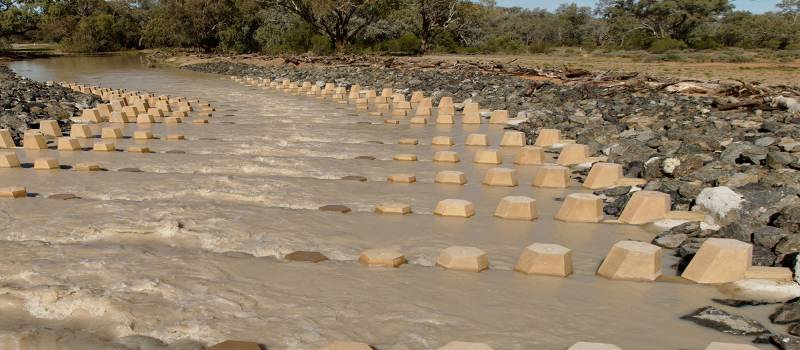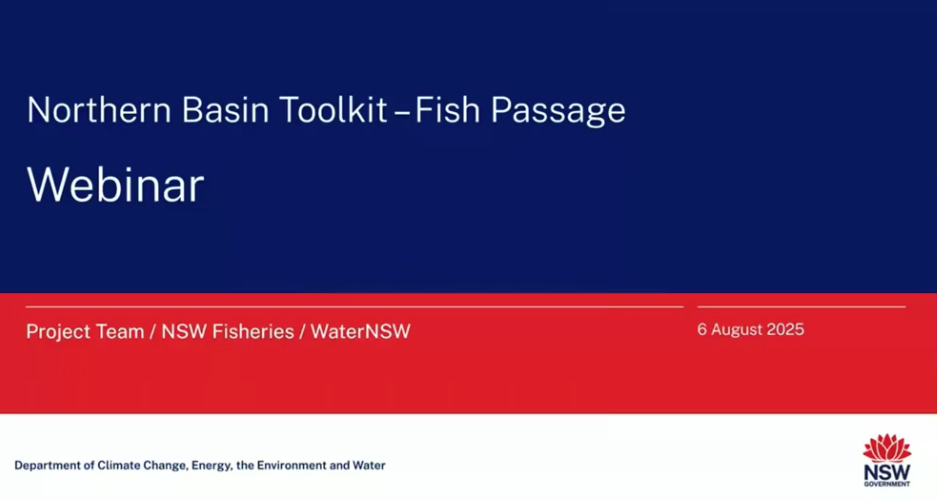Community drop-in sessions
Community drop-in sessions will be held in Tilpa, Louth, Walgett, Collarenebri and online between Tuesday 28 October and Wednesday 5 November 2025. The sessions are an opportunity for the community to learn more about the updated fishway designs for Tilpa, Louth, Banarway and Calmundi weirs and provide feedback.
Learn more about the information sessions
View the recent media release concerning the revised fishway designs.
About the project
The Fish Passage: Reconnecting the Northern Basin project seeks to reinstate waterways to allow native fish to flourish, while at the same time balancing the needs of local water users.
The project involves:
- the incorporation of partial width rock-ramp fishways at the existing weir sites at Banarway, Calmundi, Louth and Tilpa to improve fish passage
- the removal of an unlicensed structure on the Darling-Baaka River.
Native fish need to migrate to complete key life stages and to avoid drying habitats during drought. The distance migrated ranges from a few kilometres to entire river systems in the case of species like Golden Perch.
The project aims to address barriers to fish passage by installing fishways on infrastructure within our river systems.
The project would reinstate 506km of fish passage along the Barwon-Darling River system and 83km of fish passage along the Macintyre River.
Project status
Fishways
The department recognises the importance of carefully balancing the needs of water users and the environment.
Following extensive feedback from stakeholders, the department had been working closely with the NSW Department of Primary Industries and Regional Development – Fisheries to investigate a new design for the fishways.
The NSW Government recognises the communities of Louth, Tilpa, Collarenebri and Walgett do not want any reduction in local weir height.
The new design includes a small capping sill across part of the weir crests that will allow the fishways to operate effectively and maintain the current full supply level.
This solution enables native fish to migrate and breed, whilst maintaining the height of the weirs.
It is important to note, these weirs were built in the 1950s and have developed leaks over time, leading to the loss of billions of litres of water. That is why the project also involves repairing leaks to reduce water loss.
Technical investigations will be undertaken to confirm this approach.
We continue to progress supporting activities for the fishways including the review of environmental factors, procurement strategies and licensing and agreements.
Other works
We have completed works to remove a concrete structure blocking fish migration, known as Holdfast Crossing, in September 2024. The crossing is located approximately 14km North of Yetman in the Inverell Shire. The removal reinstated more than 64km of fish passage.
Works to remove an unlicensed structure on the Darling-Baaka are expected to begin in late 2025.
Project benefits
The project will generate significant benefits including:
- increased movement of native fish species across the northern NSW Murray-Darling Basin
- increased abundance of native fish species in the system
- enhanced cultural values for First Nations communities (native fish are an important part of First Nations cultures in the region)
- support for regional economies and the creation of local job opportunities during construction
- increased regional tourism opportunities as native fish populations increase.
Project funding
The project is funded by the Australian Government and is being delivered to support the Murray–Darling Basin Plan by the department in partnership with the Department of Primary Industries and Regional Development – Fisheries.
The Australian Government has allocated up to $56.8 million to fund the project.
About fishways
Fishways are structures placed on or around constructed barriers, such as dams or weirs, to provide a passageway to help fish migrate safely upstream and downstream.
Find out more about the different types of fishways, or view fishway diagrams below:
Download a copy of the fishways diagrams.
Fishways design
The proposed fishway design provides a balanced solution that acknowledges all needs of the various stakeholders. The benefits of the balanced approach include:
- fish passage outcomes
- minimal impact to water users
- long term benefits with reduced leakage and remediated infrastructure
- mitigation of out of channel flooding implications
- maintenance of upstream aquatic habitats
- no increase in operation cost to NSW Government and Water NSW
- flexibility for future infrastructure changes.
Download a copy of the artist’s impressions.
Stakeholder engagement
We continue to provide opportunities for local communities and stakeholders to have their say on the project throughout its stages of development and delivery, and this feedback will be used as a key input into project decision-making.
A What We Heard Report that captures stakeholder and community feedback on the Fish Passage: Reconnecting the Northern Basin project between January - August 2025 is now available.
Report
A What We Heard Report that captures stakeholder and community feedback on the Fish Passage: Reconnecting the Northern Basin project between January - August 2025 is now available.
Join us at an upcoming community drop-in session
The Water Group is holding community drop-in sessions in Tilpa, Louth, Walgett and Collarenebri, as well as an online webinar, between Tuesday 28 October and Wednesday 5 November 2025.
The sessions are an opportunity for the community and stakeholders to learn more about the revised fishway designs and provide feedback.
Tipla
When: Tuesday 28 October 2025
Where: Tilpa Community Hall, 1 Darling Street, Tilpa, NSW, 2840
Time: 10am – 11am
Registration is not required to attend this session.
Louth
When: Tuesday 28 October 2025
Where: Louth Tennis Club, 30 Bloxham Street, Louth, NSW, 2840
Time: 1:30pm – 2:30pm
Registration is not required to attend this session.
Walgett
When: Wednesday 29 October 2025
Where: Walgett Sports Club, 10 Montkeila Street, Walgett, NSW, 2832
Time: 10am – 11am
Registration is not required to attend this session.
Collarenebri
When: Wednesday 29 October 2025
Where: Collarenebri Sports Club, 26 - 30 Walgett Street, Collarenebri, NSW, 2833
Time: 1pm – 2pm
Registration is not required to attend this session.
Subscribe to our mailing list to be notified of the details of future engagement activities for the project.
Engagement with First Nations people
We recognise and acknowledge the unique relationship and deep Connection-to-Country First Nations people have as the Traditional Owners and First Peoples of Australia.
The wisdom and experience of First Nations communities will play a role in informing our approach. We have a dedicated engagement team who will guide our engagement with these communities, and we look forward to working with them to deliver real and tangible outcomes.
Contact us
For more information call us on 1300 081 047 or email us at water.enquiries@dcceew.nsw.gov.au





